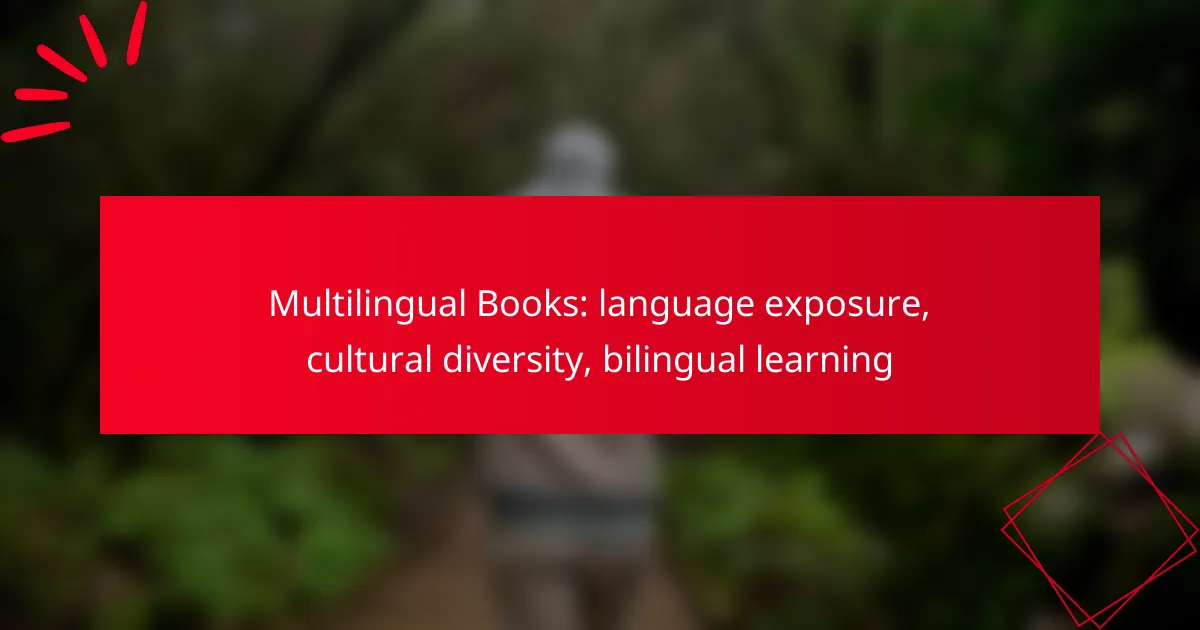Multilingual books play a crucial role in enhancing language exposure and promoting cultural diversity, particularly in multicultural settings like Canada. By offering readers the opportunity to engage with multiple languages and perspectives, these books foster bilingualism and deepen cultural understanding, making them invaluable resources for language learning and appreciation.

How do multilingual books enhance language exposure in Canada?
Multilingual books significantly enhance language exposure in Canada by providing diverse linguistic experiences that reflect the country’s multicultural fabric. These books allow readers to engage with multiple languages simultaneously, promoting bilingualism and cultural understanding.
Increased vocabulary acquisition
Multilingual books facilitate increased vocabulary acquisition by presenting words and phrases in different languages side by side. This exposure helps readers make connections between languages, reinforcing their understanding of vocabulary in both their native and target languages.
For instance, a child reading a story in English and French can learn new words in both languages, enhancing their ability to express ideas and emotions. This dual exposure can lead to a richer vocabulary that spans multiple languages.
Improved listening skills
Listening skills improve as readers engage with multilingual books, especially when they are accompanied by audio components. Hearing the pronunciation of words in different languages helps learners develop better auditory discrimination and comprehension.
In Canada, where many communities are bilingual or multilingual, listening to stories read in various languages can enhance understanding and appreciation of linguistic nuances. This practice encourages learners to become more attentive listeners, which is crucial for effective communication.
Enhanced reading comprehension
Reading comprehension is enhanced through the use of multilingual books as they encourage readers to think critically about language and context. By navigating between languages, readers develop skills to infer meaning and understand cultural references more deeply.
For example, a student reading a bilingual text may need to interpret idiomatic expressions or cultural contexts that differ between languages, fostering a more comprehensive understanding of the material. This skill is particularly valuable in Canada’s diverse educational landscape, where students encounter various languages and cultures.

What are the benefits of cultural diversity in multilingual books?
Cultural diversity in multilingual books enriches readers’ experiences by exposing them to various perspectives and ways of life. This exposure fosters a deeper understanding of global cultures, enhancing both language skills and cultural appreciation.
Broader worldviews
Multilingual books provide insights into different cultures, allowing readers to see the world through diverse lenses. By engaging with stories from various backgrounds, individuals can expand their understanding of global issues and cultural nuances.
For instance, a child reading a story set in a different country can learn about its customs, geography, and social dynamics, which broadens their worldview. This kind of exposure is essential in an increasingly interconnected world.
Promotion of empathy
Reading multilingual books encourages empathy by helping readers relate to characters from different backgrounds. When individuals immerse themselves in the experiences of others, they develop a greater sense of compassion and understanding.
For example, a narrative that explores the struggles of a refugee can evoke feelings of empathy in readers, prompting them to consider the challenges faced by others in real life. This emotional connection is vital for fostering inclusive communities.
Understanding of different traditions
Multilingual books often highlight unique cultural traditions, rituals, and celebrations, providing readers with a richer understanding of global diversity. This knowledge can lead to greater appreciation and respect for different ways of life.
For example, a book that describes a traditional festival from another culture can inspire curiosity and interest in learning more about that culture’s practices. Such understanding promotes cultural exchange and dialogue, essential for harmonious coexistence.

How can bilingual learning be supported through multilingual books?
Bilingual learning can be effectively supported through multilingual books by providing exposure to multiple languages and cultures, enhancing language skills and cultural understanding. These books serve as valuable resources that encourage engagement and interaction in both languages.
Dual-language formats
Dual-language formats present text in two languages side by side, allowing readers to compare and contrast languages easily. This format helps learners to make connections between vocabulary and grammar in both languages, reinforcing their understanding. For example, a story might be presented in English on one page and Spanish on the next, facilitating simultaneous learning.
When selecting dual-language books, consider the proficiency level of the reader. Choose texts that match their language skills to avoid frustration and promote confidence. Additionally, look for books that include cultural context, as this enriches the learning experience.
Interactive reading strategies
Interactive reading strategies involve engaging with the text through discussions, questions, and activities. Encourage readers to summarize sections in both languages, ask open-ended questions, or predict what will happen next. This active involvement enhances comprehension and retention of vocabulary.
Utilizing techniques like role-playing or dramatization can also make reading more dynamic. For instance, readers can act out scenes from the book in both languages, which helps solidify their understanding and makes learning enjoyable.
Use of visual aids
Visual aids, such as illustrations, charts, and photographs, can significantly enhance the learning experience with multilingual books. They provide context and support comprehension, especially for visual learners. For example, a picture dictionary format can help learners associate words with images, making vocabulary acquisition easier.
Incorporating visual aids into reading sessions can also involve using flashcards or digital tools that reinforce language concepts. This approach not only aids memory but also makes the learning process more interactive and engaging, catering to various learning styles.

What criteria should be considered when selecting multilingual books?
When selecting multilingual books, consider age appropriateness, language proficiency levels, and cultural relevance. These criteria ensure that the books are suitable for the intended audience and effectively support bilingual learning and cultural exposure.
Age appropriateness
Age appropriateness is crucial when choosing multilingual books, as content should align with the developmental stage of the reader. Books for younger children often feature simple vocabulary and engaging illustrations, while those for older readers may include more complex narratives and themes.
For example, picture books are ideal for toddlers and preschoolers, while chapter books may be more suitable for children aged 7 to 12. Always check the recommended age range provided by publishers to ensure a good fit.
Language proficiency levels
Assessing language proficiency levels helps ensure that readers can understand and engage with the text. Books should match the reader’s current language skills, whether they are beginners or more advanced learners.
For beginners, look for books with basic vocabulary and repetitive phrases. Intermediate learners might benefit from stories that introduce new words in context, while advanced readers can handle more nuanced language and complex sentence structures.
Cultural relevance
Cultural relevance enhances the learning experience by providing insights into different traditions, values, and perspectives. Selecting books that reflect the cultural backgrounds of the languages being learned can foster a deeper understanding and appreciation of diversity.
Consider books that showcase folklore, history, or contemporary life in the cultures associated with the languages. This not only enriches the reading experience but also encourages discussions about cultural differences and similarities.

Which popular multilingual book series are available in Canada?
In Canada, several popular multilingual book series cater to diverse language exposure and cultural appreciation. These series are designed to support bilingual learning and promote cultural diversity through engaging stories and illustrations.
Little Linguist series
The Little Linguist series is aimed at young readers and introduces them to various languages through simple, relatable stories. Each book features a different language alongside English, making it easy for children to grasp basic vocabulary and phrases.
This series often includes vibrant illustrations that enhance understanding and retention. Parents can use these books to foster early language skills and cultural awareness in their children.
Global Babies collection
The Global Babies collection showcases infants from around the world, highlighting cultural diversity through photographs and simple text. Each book in the series is bilingual, featuring English and another language, which helps children learn about different cultures while expanding their language skills.
This collection is particularly useful for teaching empathy and global awareness, as it presents babies from various backgrounds in a relatable manner. It encourages discussions about cultural differences and similarities among young readers.
My First Bilingual Books
My First Bilingual Books is designed for toddlers and preschoolers, offering a range of topics from animals to everyday objects. Each book presents words and phrases in two languages, typically English and a second language, making it an excellent resource for early bilingual education.
These books often include interactive elements, such as questions and prompts, to engage children actively. Parents can use them to create a fun learning environment that promotes language acquisition and cultural curiosity.

How do multilingual books compare to traditional language learning methods?
Multilingual books offer a unique approach to language learning that contrasts with traditional methods by integrating storytelling and cultural context. They provide immersive experiences that can enhance engagement and retention compared to conventional classroom settings.
Engagement through storytelling
Storytelling in multilingual books captures readers’ attention and fosters emotional connections, making language learning more enjoyable. Engaging narratives can motivate learners to explore new languages and cultures, often leading to deeper understanding and appreciation.
For example, a bilingual story featuring relatable characters can encourage readers to practice vocabulary and grammar in context, rather than through rote memorization. This immersive experience can significantly enhance language acquisition.
Contextual learning advantages
Multilingual books provide contextual learning opportunities that traditional methods may lack. By presenting language within cultural narratives, readers can better grasp idiomatic expressions, social norms, and cultural nuances that are essential for effective communication.
For instance, a story set in a specific cultural background can illustrate how language is used in real-life situations, helping learners understand when and how to use certain phrases appropriately. This context-rich approach can lead to more meaningful language retention.
Accessibility of resources
Multilingual books are increasingly accessible, with many available in various formats such as print, e-books, and audiobooks. This variety allows learners to choose resources that best fit their preferences and learning styles, making language exposure more convenient.
Additionally, many libraries and online platforms offer multilingual books for free or at low cost, ensuring that learners from diverse backgrounds can access quality language materials. This accessibility promotes inclusivity and supports language learning across different demographics.


